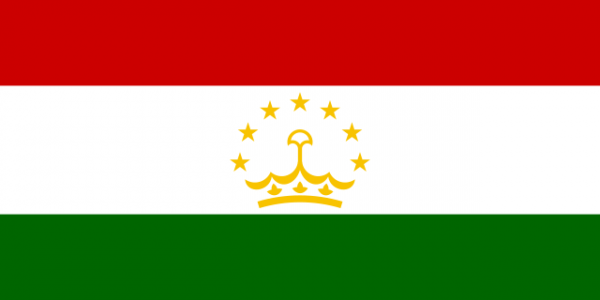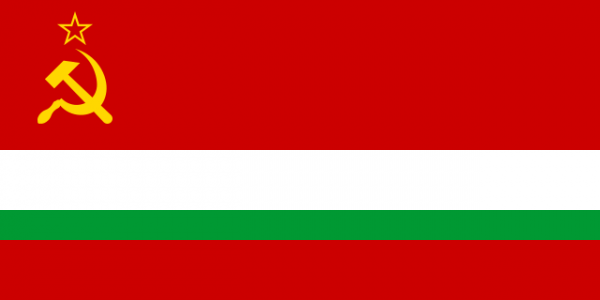The flag of Tajikistan – both as a Soviet Republic and an independent country – feature the pan-Iranian colours of red, white, and green. This was a rare, if welcome nod from the USSR to Tajikistan’s Persian heritage, in contrast to the other Central Asian republics, which had largely Turkic populations.
Upon independence, these colours were retained in a new tricolour flag, which it incorporated a golden emblem into the centre of. While the current design resembles the Iranian flag in many ways – therefore making it less distinct among a category of Central Asian flags featuring eagles, carpets, and yurts – it still has an interesting symbolism and history.

History of the flag of Tajikistan:
The flag of the Tajik SSR underwent several changes from when it was first designed in the 1920s. What is now Tajikistan was originally placed under the jurisdiction of the Uzbek SSR, so it did not have its own flag until 1929.
While the first designs included the coat of arms, this was replaced by 1933 by a plain-red flag featuring the gold inscription “Tajik SSR” in Tajik only. This was originally in the Latin script, while Russian-language writing was then added along with a hammer and sickle in 1936. Eventually, the Tajik was converted into Cyrillic along with the USSR’s other minority languages in 1940.

The final version was adopted in 1953, featuring a red background with a horizontal white stripe in the middle, and a smaller green stripe below it. The red symbolized the revolutionary struggle, while the white and green stripes represented the cotton industry and agriculture respectively, which also featured on the Uzbek flag. The emblematic hammer and sickle with a red star in the top corner completed the Soviet design.
The Tajik SSR flag was the only SSR flag to display the pan-Iranian colours of red, white and green, an uncharacteristically sensitive acknowledgement by the USSR to Tajikistan’s Persian culture and heritage, which separates them from the Turkic peoples that make up the ethnic majorities of all the other Central Asian countries.
Symbolism of the flag of Tajikistan:
At the time of Independence, Tajikistan decided to keep the pan-Iranian colours that had featured on its Soviet flag. However, it converted the design into a tricolour flag and added the golden crown symbol in the centre.
The word “Tajik” is derived from the Persian word “taj,” meaning crown. In Tajik traditional legends, the number seven holds great significance. According to these legends, there are seven mountains in the heavens, each topped with a golden star, along with seven orchards. The number seven is also associated with purity and happiness, symbolizing important cultural and spiritual concepts within the Tajik tradition.
But is this the most interesting thing about the flag?
Perhaps even more intriguing than the flag itself is Dushanbe’s flagpole, which has certainly piqued our interest. We have a soft spot for the “biggest something” in Central Asia, and what could be more impressive than the tallest flagpole?
Until May 2011, Azerbaijan held the title for the world’s tallest flagpole, but after two years of design and construction, Tajikistan claimed the title. Standing at 165 meters and costing $3.5 million, the pole flies a flag of Tajikistan that weighs 700 kg.
Located in front of the Palace of Nations in the capital, this site is not only impressive but also a pleasant place to visit, featuring a man-made lake surrounded by a beautifully landscaped park with rides, games, and food stalls. In summer, it buzzes with locals enjoying their time. Today, it is the fifth tallest flagpole in the world, having been beaten by Saudi Arabia in 2014.
Having been to both, however, the one in Dushanbe appears even more impressive. Perhaps this is because it’s situated in a lovely park where visitors can truly appreciate its height, as opposed to being positioned in the middle of a roundabout, far from the town center, as it is in Jeddah.
How can I visit Tajikistan to see for myself?
We’ve been offering tours to Tajikistan for years, so we have gotten to know the country very well! All of our trips take you to see the Dushanbe flagpole, and both the flag of Tajikistan and other national symbols are commonplace across the country.
Depending on your budget, dates, and wants, you may choose to join one of our group tours, or else we can help you orgniaze a private tour. Either way, we recommend checking out our Tajikistan page here, or getting in contact with us if you have any questions!





